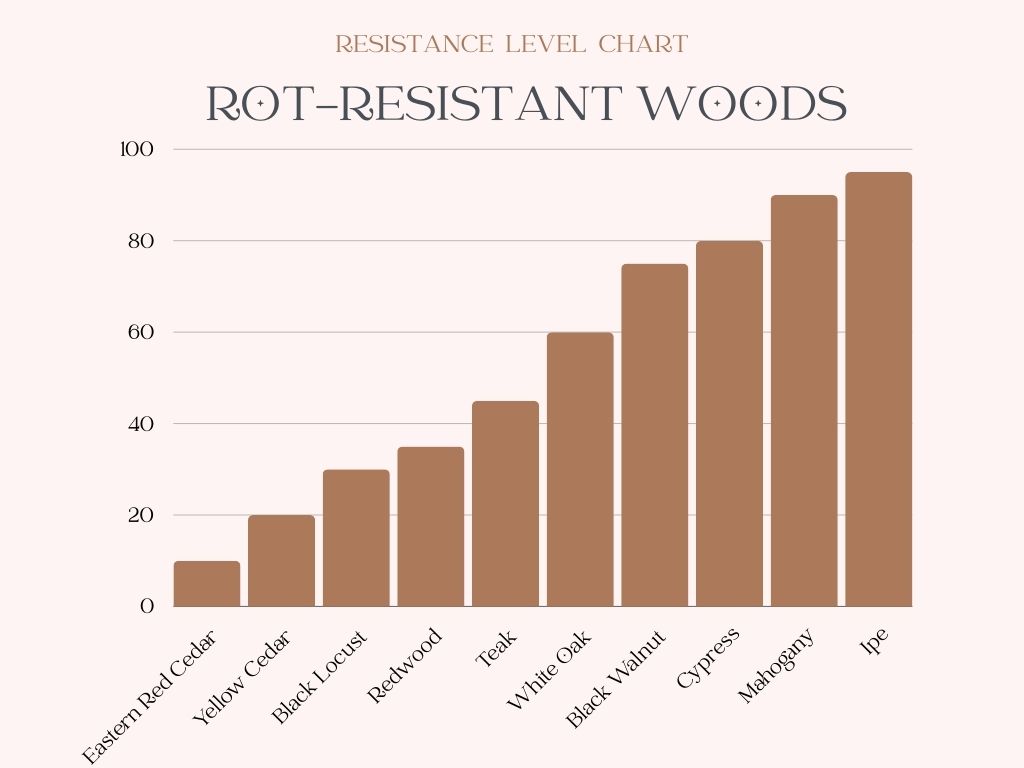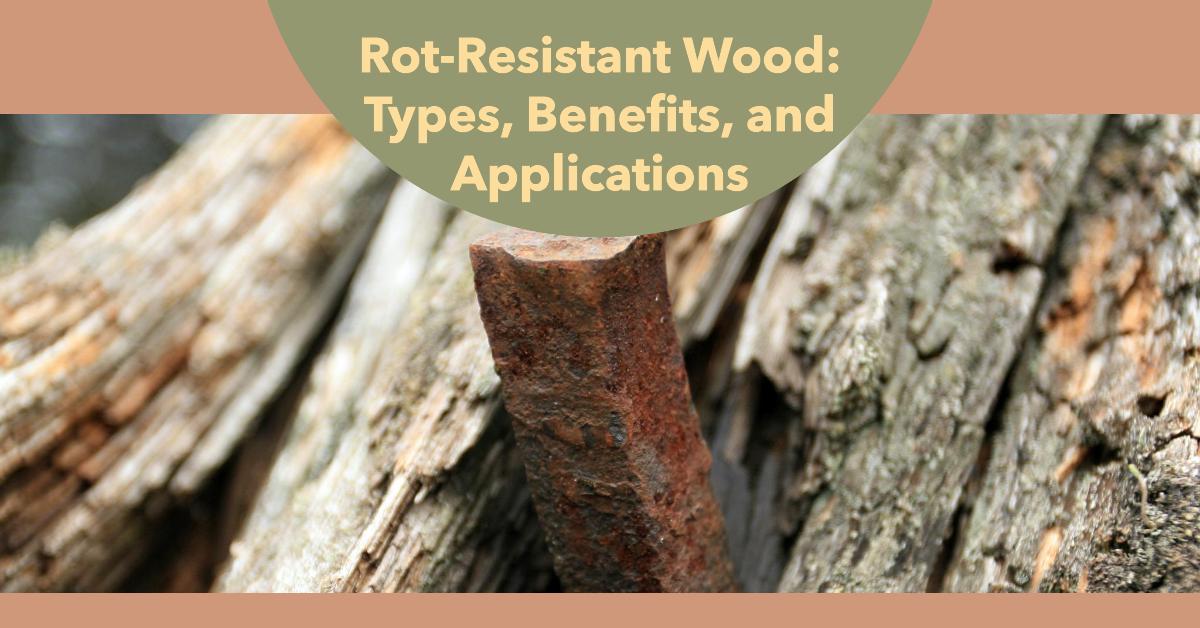We all have seen some woods get rotten in a few years while others stay the same for decades. Why does it happen? Well, this is because each wood has its resistance level to insects, rot, and decay. Thus, choosing the best rot-resistant wood for various purposes, especially for building outdoor furniture becomes very important. In this article, we will ponder upon timber woods that are highly rot-resistant and can last for years.
What is Rot-Resistant Wood?
It refers to the types of wood that possess properties that help them to resist decay and rot naturally. Woods like mahogany, walnut, and cedar when exposed to moisture, fungi & insects show an immense amount of resistance in comparison to pine, birch, and maple which are less rot-resistant. Due to the presence of natural oils, resins, or chemicals in the heartwood of these woods, they are highly protected against harsh weather conditions and thus are costlier. However, there are methods like pressure treating of wood that are used for enhancing the rot-resistance levels of wood artificially with the help of chemicals and adhesives for alternatives to naturally rot-resistant woods.
Rot-Resistance Levels of Various Woods

Benefits of Choosing Rot-Resistant Wood
Choosing decay-resistant wood offers numerous benefits for outdoor projects.
- Firstly, it provides longevity, as decay-resistant woods have a longer lifespan than untreated lumber, reducing the need for frequent replacements.
- These rot-proof woods require minimal maintenance which saves a lot of time and effort. However, these are initially quite expensive to install but save a lot over a longer time.
- Due to their high durability, they are more sustainable than ordinary wood.
- With their natural beauty and versatile applications, rot-proof woods like cedar and redwood enhance the aesthetic appeal of outdoor furniture while offering durability & reliability in various environmental conditions.
Popular Rot-Resistant Wood Types
1. Black Locust
Black locust is a highly dense wood found mostly in eastern parts of the United States. With a Janka hardness of 1700 lbf (7600 N), it boasts high durability and can last for over 40 years. Although this wood is somewhat difficult to work with because of its dense grain on the flip side it naturally protects it from getting witherd when exposed to insects or damp weather conditions. Black Locust is widely used for furniture making, decking, fencing, & outdoor structures.
2. Black Walnut
A premium hardwood that has a dark hue and captivating grain pattern which is responsible for its shiny appearance. Less dense than Black Locust but enough to protect itself from decaying for years. Its attractive grain patterns should be given all the credit for its extensive usage in flooring and for other decorative purposes. Despite its premium price tag, its adaptability and aesthetic allure make it a worthwhile investment in woodworking projects.
3. Atlantic White Cedar
It is another highly durable wood on our list that shows exceptional resistance to rot & insects. Its innate oils and extractives form a natural shield against the changing environment. Its excellent stability and decay resistance make it suitable for boatbuilding, carving, siding, shingles, and construction lumber. Due to its limited growing range, Atlantic White Cedar tends to be more expensive than many other conifers in the eastern United States.
4. Western Red Cedar
Western Red Cedar is a popular softwood known for its natural resistance to water and rot, which is why it is a go-to choice for decking and other outdoor structures. The presence of natural oils and resins provides a distinct odor and aroma that helps protect it against harmful termites. Moreover, its lightweight and straight grain pattern adds to the woodworker’s delight. With a little bit of maintenance and caution the Western Red Cedar could last for a good 30+ years.
5. Spanish Cedar
Spanish Cedar is super tough and won’t easily decay, even when faced with harsh weather. It’s great for outdoors and can handle all kinds of conditions. Plus, it’s cheaper than mahogany but just as strong. It starts with a reddish-brown color that gets darker over time, adding a touch of elegance to any project. Whether it’s for window trim, exterior work, closets, or chests, Spanish Cedar is a popular choice because it’s easy to work with and lasts very long. So, even though it might cost a bit more upfront, it’s a smart investment for outdoor projects.
6. Douglas Fir
Douglas-fir, widely renowned and abundantly available, holds a prominent place in construction and building projects, particularly in the United States. Despite being classified as a softwood, it ranks among the toughest commercially available species in the region. While its heartwood demonstrates moderate resistance to decay, it remains susceptible to insects. However, its ease of workability renders it a favorable option for various outdoor applications.
7. White Oak
White oak a much talked about wood on Timber Explore is prized for its versatility and durability, making it a top choice for furniture making, whether for indoor or outdoor use. Its abundance and availability in various dimensions further contribute to its appeal to craftsmen. Renowned for its resistance to rot and ease of manipulation, white oak is reliable for enduring furniture pieces. Its straight grain and inherent durability guarantee that well-cared-for white oak furniture can endure for decades, proving its longevity over time.
8. Teak
There are many types of teak wood, however, natural teak has a straight grain with a golden hue. It is one of the most durable woods out there. Teak hardwood contains a high amount of natural oils, which helps it to withstand moisture and decay conditions for a long time. Despite being an expensive lumber it is a popular choice for those requiring high rot resistance for their furniture, carving, flooring, and other building needs.
9. Redwood
Redwood with its distinctive light pinkish-brown heartwood and pale yellow sapwood, exudes natural elegance. It is one of the best naturally rot-resistant woods on our list. Its easy workability and reputation for being incredibly rot-proof make it perfect for outdoor projects like wood siding. So, even though it might cost more than other woods, its toughness and great appearance make it a popular option.
10. Osage Orange
Wood from the Osage Orange tree is so hard that it’s good at resisting external damage. Moreover, it’s great at keeping away rot & pesky insects, thanks to its dense heartwood containing natural chemicals that inhibit decay and insect infestation. Even though you might not see it as often as other types of wood, it’s worth considering for outdoor projects like making fence posts or siding.
11. Mahogany
Mahogany wood is super strong and tough, making it good at resisting water damage and rot. With exceptional strength & durability, it embodies resilience in every grain. Mahogany’s fine texture and hues ranging from grey to brown contribute to its natural allure, making it a staple in woodworking. Even with its high cost and moderate resistance to rot & decay when compared to other woods, Mahogany still solidifies its status as a premier choice for upscale outdoor projects like boat building and decking.
12. Cypress
Cypress wood boasts natural oils that make it resistant to both rot and insects. Over time, if left unfinished, it weathers to a charming silver-gray hue, similar to cedar. The heartwood of cypress showcases a spectrum of colors from light yellow-brown to reddish and dark brown. Highly valued for its exceptional resistance to rot, it is a preferred option for outdoor projects like siding, decking, and outdoor furniture.
13. Pacific Yew
Pacific Yew, with its moderate resistance to rot, offers a unique blend of durability and charm for outdoor projects. Its dense heartwood, imbued with natural chemicals, provides a solid defense against decay. While not as readily available as other woods, its durability and distinctive appearance make it a desirable choice.
How to Choose the Best Rot-Resistant Wood?
Selecting the ideal rot-resistant wood for your project involves considering several factors, including the wood species, treatment options, and intended use. Firstly, identify the specific environmental conditions your project will face, such as exposure to moisture or insect activity, to determine the level of rot resistance required.
Research wood species that are known for their rot resistance, such as cedar, redwood, or teak, and assess their availability and cost. Additionally, consider whether treated lumber is necessary for your application, as pressure-treated wood can offer enhanced protection against decay. Evaluate the wood’s appearance, durability, and ease of maintenance to ensure it meets your aesthetic and functional requirements. By carefully weighing these factors, you can choose the best rot-resistant wood for your project that offers longevity and value.

